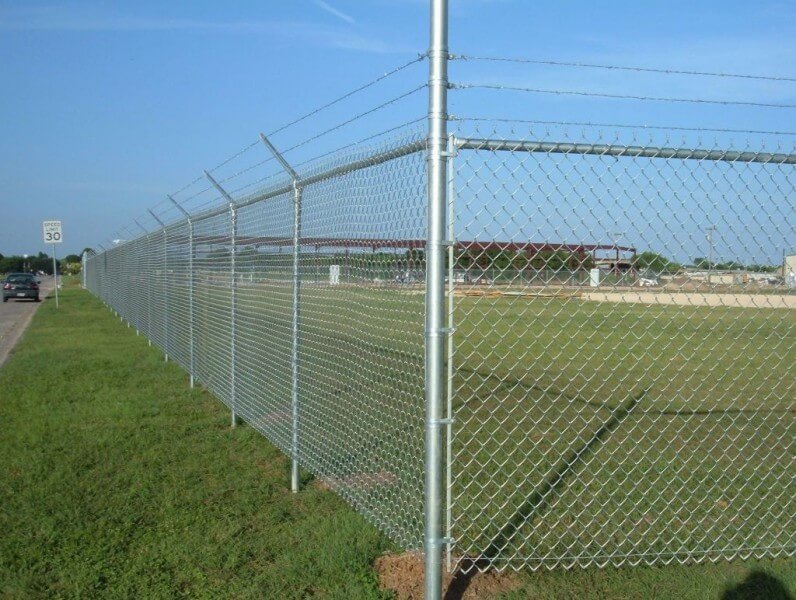Chain Link Fence Installation: DIY, Costs, and Benefits
Thinking about installing a chain link fence yourself? You’re not alone, many homeowners and business owners consider the DIY route to save a little money and get the job done on their own schedule. While chain link fences are known for being durable and straightforward to put up, there’s still a fair bit of planning, measuring, digging, and heavy lifting involved. If you’re handy and up for a challenge, a DIY chain link fence might be a good fit. But if you’d rather leave the hard work to the pros, Texas Fence has the best fence installers in the industry, ready to make your project easy, fast, and built to last.
How to Install a Chain Link Fence
To install a chain link fence, begin by planning the layout and marking the fence line. Then, dig post holes, set posts in concrete, attach the top rail, unroll and stretch the wire mesh, secure it to the top rail and line posts, install tension bands and tighten the mesh, and finally install gates and add any necessary finishing touches. Always consult with a professional or refer to local regulations for specific requirements.

Tools and Materials Needed
Once you’ve committed to a chain link fence installation, the next step is gathering the necessary tools and materials. Working with the right tools will not only make installation easier but also ensure that the project is completed efficiently.
Tools for Chain Link Fence Installation
First, let’s talk about the tools. You’ll need quite a few for this job.
- A post-hole digger: This tool helps create holes in the ground for setting up the posts.
- A level: Essential for ensuring that your posts are set at the correct height, and your fence is straight.
- Pliers: Handy for various tasks like twisting and cutting wire.
- A tension bar: Crucial for tightening the fence.
- Come-along tool: Not absolutely necessary, but useful for stretching the fence fabric during installation.
Remember, using these tools correctly and safely is vital to the success of your project.
Materials
Now, let’s move on to the materials needed.
- Chain-link fabric: Essential to create the main body of your fence.
- Line posts and terminal posts: Vertical metal posts supporting your fence.
- Top rail: Horizontal pipe running along the top of your fence sections.
- Tension bands: Secure the chain-link fabric to the terminal posts.
- Gate components: Pick up gate hinges, latches, and other necessary hardware if you plan to include a gate in your fence.
- Concrete mix: For setting the posts and ensuring structural integrity.
It’s important to ensure that all your materials are on hand before starting your project. Sometimes certain materials may need to be ordered ahead of time.
Preparing the Installation Area
Before erecting a fence, it’s essential to review all regulations regarding its placement and dimensions. Different towns have varying rules about fence height, proximity to the property line, and the necessity of permits. But fret not; most town halls boast a planning department with accommodating individuals ready to address your concerns.
Double-check these regulations while also inquiring about any necessary approvals from neighbors. This step is critical because you wouldn’t want to labor through installing a fence only to discover that it needs to be removed due to incorrect placement.
Clearing the Area
Now, let’s ensure that the area is free from obstructions for installation—just like you would tidy up a kitchen before embarking on cooking.
- Traverse the area where your fence will be situated and clear away branches, stones, plants, or any other detritus that could impede your progress.
- While doing so, ascertain that there are no significant dips or hills along the fence line, as these could pose challenges when setting up the posts.
It’s also wise to keep any shrubs or plants trimmed back from where your fence will stand. This facilitates the work process and maintains a tidy appearance.
Preparing the installation area is akin to laying out ingredients before embarking on a baking project—a necessary step for everything to proceed smoothly. And remember, by adhering to local regulations and clearing the area in advance, you’re ensuring that your fence installation will progress seamlessly!
Measuring for the Fence
When building a fence, accurate measurements are crucial for ordering the right materials, creating space for gates, and defining the fence line. Let’s delve into how to get this process right.
You’ll want to start by mapping your perimeter. This involves measuring the area where the fence will go, accounting for corners and endpoints. Once you have the measurements, visualize the fence line using stakes and string; it’s like outlining before coloring in a picture. This step may seem simple, but accuracy is key—mistakes can lead to extra costs and rework later on.
For example, imagine if we didn’t measure correctly and our fence ended up too short! We’d have to acquire more materials and redo sections—talk about unnecessary hassle. Precise measurements will help avoid these frustrations.
Another essential aspect when measuring for your fence is confirming the gate placement. Take time to decide where you want your gates to be and measure the spaces accordingly, ensuring they align with your chosen gate size. You don’t want narrow openings that make it difficult to move things in and out of your enclosed space.
Wouldn’t it be terrible if we had to take down our new fence just because the gate didn’t fit properly? Trust me, planning this out now will save us a lot of trouble in the long run.
Measuring for your chain link fence might not be the most exciting part of the process, but it’s definitely one of the most essential. It sets the stage for every subsequent step—ensuring that all goes smoothly and that you don’t encounter any unexpected issues down the line.
Locating the Gates
Finding the right spot for gates is crucial. It’s like finding the perfect entryway into your home, but, in this case, it’s for your outdoor space! Choosing where the gates will go depends on several important factors, and thinking this through carefully at this stage can save you a lot of hassle later.
Convenience: Think about how you’ll be using your gate. Who will be using it and when? If you have a big backyard, consider having more than one gate to avoid walking all the way around when you need to access another part of your yard. It’s akin to planning where to put doors inside your house for an easy flow from room to room.
For example, if you’ll be taking equipment or machinery in and out of your yard, a larger, double-gate might be helpful. If it’s for everyday use by pedestrians, a single standard gate could suffice.
Potential Obstructions: Look around and ensure nothing is blocking where you want your gate to go. A big tree branch or a sloping area can disrupt your plans. Ensuring that there are no large roots or rocks interfering with the gate swing is crucial as well.
Maintenance Access: Consider how you’re going to take care of your fence once it’s up. Access points not only allow for easy entry into enclosed areas but also simplify regular maintenance tasks and repairs. For example, spacing gates near key maintenance areas like garden beds or lawn care properties.
Keep these considerations in mind when figuring out where the gates should go because once they’re in place, moving them can be quite challenging! Taking our time now can help us avoid headaches later on.
Lastly, ensure that the locations are not too close to where utilities are buried underground to avoid damaging any lines or pipes during install.
Choosing the right spots for your gates is vital—and remember, it’s not just an entry point; it’s also about ensuring ease of usage and future maintenance. Now that we’ve identified suitable locations for our gates, it’s time we move forward with our chain link fence installation process.
Preparing the Ground
Before kicking off the actual installation, it’s pivotal to properly ready the ground. First thing’s first—equip yourself with a pair of sturdy gloves and some comfortable, protective work gear.
Clearing the Area
The initial step involves clearing out the area where you’ll be erecting your fence. This entails removing any rocks, tree roots, or debris that could obstruct digging the post holes. This is crucial to ensure that the posts sit securely, enabling your fence to stand tall and straight.
Remember: Our goal here is to create a level surface for your fence. This foundation will influence how well your fence endures over time. Take ample time with this step, ensuring the ground is flat and free of obstructions.
Imagine preparing the ground for your fence as similar to laying down a solid, even base before constructing a house. Just as you wouldn’t want to lay foundations on uneven or unstable ground, so would you not with a fence—the ground preparation sets the stage for a successful installation.
Marking Post Locations
To ensure precision and uniformity, mark out the specific locations for each post using stakes or spray paint. This guarantees that each post is positioned at equal intervals along your property line.
Placing these markers also allows you to visualize where your fence line will run, giving you a clearer idea of how your property will look with the new addition. Visualizing can help you avoid surprises later on.
After effectively clearing and marking out the area, it’s time to begin digging those all-important post holes—an indispensable process in establishing a firm foundation for your chain link fence installation. Grab your post-hole digger, and let’s get started!
Installing the Posts and Fence
Installing the posts is where your fence starts to really take shape. It’s crucial to get this part right for a sturdy, long-lasting result. When setting the line posts, precision ensures that each post is correctly positioned and aligned.
We always ensure that the posts are equally spaced along the fence line. It’s important for both aesthetics and support. We measure carefully from one end to the other and mark where each post will go. Some find it helpful to use stakes and string to keep everything in a straight line before they begin digging those holes.
Once the spots are marked out, we dig our holes—the hard part, but an essential task to make sure the posts are secure. These holes need to be deep enough so that at least a third of the post’s height is underground. This depth makes sure our posts are strong and won’t tip over easily.
In terms of attaching the fence fabric, we unroll it smoothly along the fence line, ensuring that there are no kinks or snags that could cause problems later on.
We use tension bands to attach the fabric to each line post – they’re designed to allow some flexibility which helps during temperature changes or weather variations. This flexibility is important because it means that when your chain link fence expands and contracts, it won’t get too strained and damaged.
This part can be fiddly work, but when you see that fence fabric taut against all those solid line posts, you’ll feel proud of yourself for sure!
So remember, attention to every detail at this stage pays dividends when it comes to a successful chain link fence installation!
Securing the Wire and Final Adjustments
With the posts firmly set, it’s time to work on stretching and securing the chain-link fabric. This is a critical step to ensure the fence is sturdy and reliable, capable of withstanding various weather conditions and external forces.
Using a come-along tool is the best way to apply the necessary tension to the chain-link fabric. The come-along tool is like a big, heavy-duty ratchet strap that’s used for pulling or lifting heavy loads. You’ll need to anchor it securely to one of the terminal posts and then use it to stretch the chain-link fabric. It’s important to put enough tension without overstretching. You want it tight, but not so tight that it ends up distorting or damaging the fence.
After the wire is taut, fasten it to the terminal posts using tension bars. These bars help keep the wire in place under tension, preventing any sagging or slack that can compromise the fence’s integrity over time.
Next comes alignment, which is essential for an impeccable finish, not only for looks but for overall durability. Ensure the fence is level, straight, and properly aligned. Any misalignment at this stage can lead to further issues down the line. This means checking both the height and orientation with a spirit level or measuring tape to ensure everything is straight and at an even height. You might need to make some adjustments along the way for a uniform and aesthetically pleasing installation.
Making these final adjustments is crucial before finishing up with securing hardware such as bolts, nuts, and tension bands. Ensuring everything is solidly secured significantly contributes to your fence’s long-term stability.
Cost and Benefits of DIY Chain Link Fence Installation
There’s nothing quite like the feeling of accomplishment that comes with successfully completing a do-it-yourself project around your property. Building a chain-link fence on your own is no exception. Besides, it can also help with keeping your budget in check, as you save money on labor costs by tackling the installation yourself.
Yes, building your own chain link fence might seem daunting at first, but think about it this way: you’ll be learning new skills and getting a workout at the same time – win, win! Moreover, when you consider how much you could save on professional installation fees, it starts to look pretty appealing. Our budget-friendly option offers both hands-on virtues and financial advantages.
Cost-Efficiency
The cost-efficiency of a DIY chain-link fence simply can’t be ignored. Labor costs often make up a significant portion of any installation work, but by taking on the project yourself, you can significantly cut down on those expenses. Just think about all the saved pennies: they add up!
Versatility is another big plus of chain-link fences. It’s not just for one type of property—these fences are suited for various areas like homes, businesses, schools, parks—practically anywhere that needs to clearly mark its limits.
Versatility
You’re not just fencing in your yard; you’re creating the perfect play area for kids or pets without breaking the bank. It’s not just commercial and recreational areas that benefit from their versatility—chain-link fences make an excellent choice for enclosing sports fields and public spaces too.
The best part? If you prefer to have professionals do the heavy lifting for you or explore other options, our team at Texas Fence provides expert installation services for chain-link fences that guarantee quality workmanship and adherence to industry standards.
Low Maintenance
Have we mentioned that these fences hardly need any maintaining? Unlike wooden fences that need regular painting or staining, a chain-link fence can take care of itself for many more years.
We’re proud to offer this option because we truly believe in harnessing the potential in every property owner to bring their vision to life. Whether it’s about sticking to a budget or finding a versatile solution suitable for different types of properties—we’ve got you covered.
In conclusion, learning new skills while saving money makes a DIY chain link fence installation rewarding. If you decide that DIY is not the right fit for you, our team at Texas Fence is fully equipped to provide expert installation services for your chain link fence. Contact us today and let us help bring your fencing vision to life!








